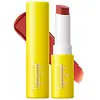What's inside
What's inside
 Key Ingredients
Key Ingredients

 Benefits
Benefits

 Concerns
Concerns

 Ingredients Side-by-side
Ingredients Side-by-side

Zinc Oxide 17.5%
Cosmetic ColorantRicinus Communis Seed Oil
MaskingCaprylic/Capric Triglyceride
MaskingJojoba Esters
EmollientEuphorbia Cerifera Wax
Persea Gratissima Oil
Skin ConditioningBis-Diglyceryl Polyacyladipate-2
EmollientAroma
Simmondsia Chinensis Seed Oil
EmollientArgania Spinosa Kernel Oil
EmollientTocopheryl Acetate
AntioxidantCopernicia Cerifera Wax
Stevioside
MaskingCetearyl Ethylhexanoate
EmollientSynthetic Fluorphlogopite
Isostearic Acid
CleansingLecithin
EmollientPolyhydroxystearic Acid
EmulsifyingPolyglyceryl-3 Polyricinoleate
EmulsifyingButyrospermum Parkii Butter
Skin ConditioningMangifera Indica Seed Butter
Skin ConditioningAstrocaryum Murumuru Seed Butter
EmollientCalcium Sodium Borosilicate
Rosa Canina Fruit Oil
EmollientSorbitan Isostearate
EmulsifyingBisabolol
MaskingVaccinium Macrocarpon Seed Oil
Skin ConditioningPortulaca Pilosa Extract
Skin ConditioningTocopherol
AntioxidantAscorbyl Palmitate
AntioxidantSucrose Cocoate
EmulsifyingGlycine Soja Oil
EmollientPalmitoyl Tripeptide-38
Skin ConditioningTin Oxide
AbrasiveTitanium Dioxide
Cosmetic ColorantCI 45410
Cosmetic ColorantIron Oxides
CI 19140
Cosmetic ColorantCI 15850
Cosmetic ColorantCI 15985
Cosmetic ColorantCI 42090
Cosmetic ColorantZinc Oxide 17.5%, Ricinus Communis Seed Oil, Caprylic/Capric Triglyceride, Jojoba Esters, Euphorbia Cerifera Wax, Persea Gratissima Oil, Bis-Diglyceryl Polyacyladipate-2, Aroma, Simmondsia Chinensis Seed Oil, Argania Spinosa Kernel Oil, Tocopheryl Acetate, Copernicia Cerifera Wax, Stevioside, Cetearyl Ethylhexanoate, Synthetic Fluorphlogopite, Isostearic Acid, Lecithin, Polyhydroxystearic Acid, Polyglyceryl-3 Polyricinoleate, Butyrospermum Parkii Butter, Mangifera Indica Seed Butter, Astrocaryum Murumuru Seed Butter, Calcium Sodium Borosilicate, Rosa Canina Fruit Oil, Sorbitan Isostearate, Bisabolol, Vaccinium Macrocarpon Seed Oil, Portulaca Pilosa Extract, Tocopherol, Ascorbyl Palmitate, Sucrose Cocoate, Glycine Soja Oil, Palmitoyl Tripeptide-38, Tin Oxide, Titanium Dioxide, CI 45410, Iron Oxides, CI 19140, CI 15850, CI 15985, CI 42090
Water
Skin ConditioningDiphenyl Dimethicone
EmollientDiisostearyl Malate
EmollientBis-Diglyceryl Polyacyladipate-2
EmollientOctyldodecanol
EmollientGlycerin
HumectantBis-Behenyl/Isostearyl/Phytosteryl Dimer Dilinoleyl Dimer Dilinoleate
EmollientHydrogenated Polyisobutene
EmollientDipropylene Glycol
HumectantCetyl PEG/PPG-10/1 Dimethicone
EmulsifyingSorbitan Isostearate
EmulsifyingPolysorbate 60
EmulsifyingPentylene Glycol
Skin ConditioningPhenoxyethanol
PreservativeHydroxyethyl Acrylate/Sodium Acryloyldimethyl Taurate Copolymer
Emulsion StabilisingMenthoxypropanediol
MaskingCeteareth-20
CleansingSqualane
EmollientParfum
MaskingSimmondsia Chinensis Seed Oil
EmollientStevioside
MaskingHelianthus Annuus Seed Oil
EmollientEthylhexylglycerin
Skin ConditioningNymphaea Odorata Root Extract
RefreshingGardenia Florida Fruit Extract
Skin ConditioningNelumbo Nucifera Flower Extract
Skin ConditioningPentaerythrityl Tetra-Di-T-Butyl Hydroxyhydrocinnamate
AntioxidantBenzyl Salicylate
PerfumingLimonene
PerfumingEugenol
PerfumingCI 77891
Cosmetic ColorantCI 15985
Cosmetic ColorantCI 17200
Cosmetic ColorantCI 45410
Cosmetic ColorantCI 42090
Cosmetic ColorantWater, Diphenyl Dimethicone, Diisostearyl Malate, Bis-Diglyceryl Polyacyladipate-2, Octyldodecanol, Glycerin, Bis-Behenyl/Isostearyl/Phytosteryl Dimer Dilinoleyl Dimer Dilinoleate, Hydrogenated Polyisobutene, Dipropylene Glycol, Cetyl PEG/PPG-10/1 Dimethicone, Sorbitan Isostearate, Polysorbate 60, Pentylene Glycol, Phenoxyethanol, Hydroxyethyl Acrylate/Sodium Acryloyldimethyl Taurate Copolymer, Menthoxypropanediol, Ceteareth-20, Squalane, Parfum, Simmondsia Chinensis Seed Oil, Stevioside, Helianthus Annuus Seed Oil, Ethylhexylglycerin, Nymphaea Odorata Root Extract, Gardenia Florida Fruit Extract, Nelumbo Nucifera Flower Extract, Pentaerythrityl Tetra-Di-T-Butyl Hydroxyhydrocinnamate, Benzyl Salicylate, Limonene, Eugenol, CI 77891, CI 15985, CI 17200, CI 45410, CI 42090
 Reviews
Reviews

Ingredients Explained
These ingredients are found in both products.
Ingredients higher up in an ingredient list are typically present in a larger amount.
This ingredient is lipid-based synthetic skin-conditioning agent derived from adipic acid and a mixture of fatty acids. It is often called a lanolin substitute.
As an emollient, it helps soften and hydrate the skin. Emollients create a barrier on the skin to trap moisture in.
Due to its fatty acid base, it may not be Malassezia folliculitis safe.
Learn more about Bis-Diglyceryl Polyacyladipate-2Ci 15985 is a dye made from petroleum. It is synthetically created and approved by the FDA for use in foods and cosmetics.
The color of this dye is orange/yellow.
This ingredient can be found in makeup, sun care, and skincare.
Learn more about CI 15985Ci 42090 is a synthetic dye created from petroleum. It is used to give a bright blue color to cosmetics, medicine, and food.
CI 45410 is a synthetic red-pigment and dye.
It often goes by both Red 28 or Red 27; manufacturers label both ingredients as CI 45410.
This dye is commonly found in makeup because it imparts a vivid color. Some types of this dye change color based on pH level and interaction with moisture:
Your skin has a natural pH of around 4.5 - 5.5.
According to the FDA, CI 45410 is not permitted for use in eye products.
Red 27 is a flourescein dye and commonly used as a fluorescent tracer in medicine.
Learn more about CI 45410This oil comes from the seeds of the desert shrub called Jojoba. It is more commonly known as jojoba oil, a non-comedogenic oil.
Jojoba oil does not contain fragrance and has many fatty-acids, making it a great soothing ingredient.
It also contains Vitamin E, a great moisturizing ingredient. Vitamin E is also an antioxidant and protects your skin against oxidative damage.
This ingredient humectant properties, meaning it helps draw moisture from the air. This helps keep your skin hydrated.
While jojoba has antibacterial properties, it is only able to kill some strains of bacteria.
Studies also show it helps in wound healing. In fact, Indigenous cultures have used jojoba as a moisturizer and to help treat burns for centuries.
Fun fact: Jojoba oil similar to natural human skin sebum, so it has a great effect on dry skin. It is also promising with helping to regulate sebum production.
Due to its fatty acid content, Jojoba oil may not be fungal acne safe. We recommend speaking with a professional if you have any concerns.
Learn more about Simmondsia Chinensis Seed OilSorbitan Isostearate is an emulsifer and cleaning agent. It is created from isostearic acid and sorbitol.
As an emulsifier, Sorbitan Isostearate prevents oils and water from separating.
Due to its isostearic acid base, it may not be safe for Malassezia or fungal acne.
Learn more about Sorbitan IsostearateWe don't have a description for Stevioside yet.